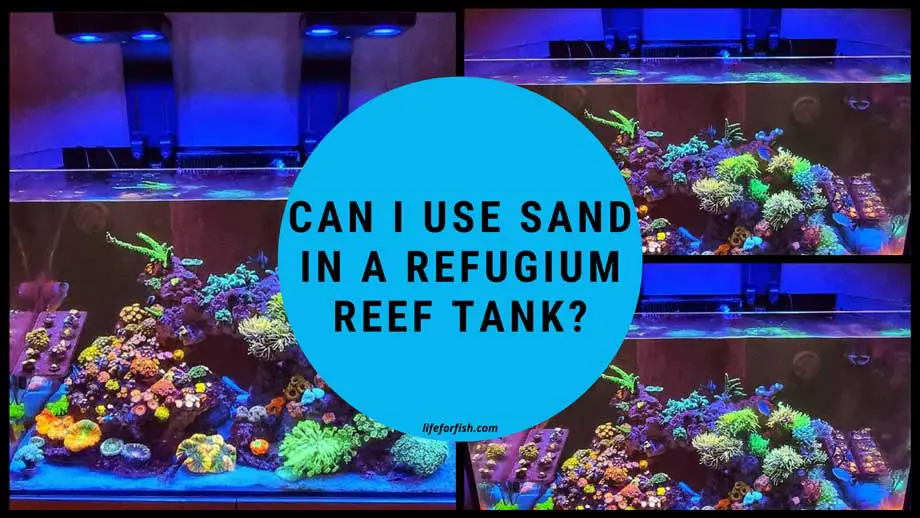Having a refugium attached to your main tank provides you with a place to keep vulnerable fish and inverts while still being connected to the main water supply. However, one of the things that troubles a lot of fish keepers is how the refugium should be set up. In particular, where you should use sand in a refugium.
Having good substrate in your refugium is essential and you will find that a very deep layer of sand is beneficial to the creatures that inhabit the refugium since it allows them to dig down or sift through.
That said, there are a wide range of other reasons that sand is a good choice. In addition, there are people who create a refugium without any substrate at all. Let’s find out more.
See Also:
Benefits Of Using Sand In A Refugium
Using sand in your refugium is an excellent idea, although if you are going to do this, then you must make sure that you use the right amount. One of the main reasons that aquarists choose to use sand in the refugium is so that the creatures inside have the option to bury down into it so making sure it is deep enough for this is a must. Most would agree that at least five to six inches of sand is the best option although there are a lot of people who go for more; up to eight inches in some cases.
Having the sand is also a good place for algae to take root. You might not think that this is overly important but it can make a nutritious meal for many of the animals that live here. Various types of fish, snails, shrimp, and crab will enjoy this benefit. Moreover, if you want to root plants to recreate conditions similar to a mangrove, sand is an essential component in this.
On top of this, sand is packed with minerals which can be hugely beneficial to the refugium and this is one of the main reasons that people choose to use it. But the sand will also act as something of a tank cleaner, without you having to do very much at all.
You see, if the sand is deep enough, there will be areas that don’t shift and it is here that there is a huge lack of oxygen which means that bacteria can turn nitrates into gas. As this happens, these gases will rise to the top of the sand in the form of an air bubble. This bubble will then rise to the surface of the water and burst and in turn, your refugium will be a lot healthier and cleaner.
The ocean floor is largely made up from the sand and when you are creating a reef tank, it is likely that you will want to create something as close to nature as possible. For this reason, sand is a popular choice for aesthetic reasons. Since you can also use it for planting, this further improves the visual appeal of the refugium.
Are There Any Downsides To Using Sand In A Refugium?
Nothing in life is perfect and as such, there are a couple of drawbacks to using sand as the main substrate in your refugium. For example, while the sand will serve a purpose in getting rid of nitrates, it may also have the opposite effect. This is because, over the course of time, nitrates will build up on the surface of the sand, making the quality of the water poorer.
Of course, this can be controlled with good sand maintenance but this does mean extra work for you. You will need to clean and replace the sand which can be quite a significant undertaking and if you’ve never done it before, it can feel intimidating. It may also involve taking everything else out of the refugium.
What Happens If I Don’t Use Sand In A Refugium?
Sand is a great choice for your refugium and even your main tank but there are reasons not to use it, as we have discovered. Quite often, when creating a refugium, a completely bare bottom is the best choice and a lot of people go for this option. This is largely because, while sand can solve a lot of issues, it will also create many others.
As we have mentioned, there can be a big waste build-up within the sand which makes for a time-consuming clean-up. Moreover, if too many nitrates are allowed to build up, this can massively affect the overall health of the refugium and the connected tank. In the worst cases, it can be deadly to all life within the aquarium.
If you are looking for something low maintenance for your refugium then a bare bottom is definitely the way to go. However, you should keep in mind that this will mean you cannot root plants and will have to opt for floating greenery instead.
Conclusion
A refugium is an essential component of a reef tank if you want a place to keep more vulnerable fish that may be prone to attacks from more prominent members of the tank community. But choosing the right substrate is a key consideration. Many people wonder if they can use sand and quite simply, this is a good choice. However, there are downsides to it, so it is important to weigh up how much time you have to dedicate to the refugium.

